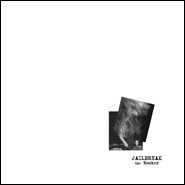What does it mean when Heather Leigh and Chris Corsano invoke the sacred world of Thin Lizzy? Their sound project, Jailbreak, is named after Thin Lizzy’s 1976 landmark album, Jailbreak, and the album is named after what is arguably the greatest rock song ever created, “The Rocker,” from Lizzy’s third album, Vagabonds Of The Western World. The song titles on The Rocker come from two more Lizzy tracks, “Brought Down” and “Sugar Blues,” which appeared on Shades Of A Blue Orphanage and Chinatown, respectively. As a rabid Thin Lizzy fanboy who, if he had more positive freedom, would travel to Dublin just to sit at the feet of the life-size Phil Lynott statue, I was droolingly excited to see the band invoked on this album. But, seriously, what does all this mean?
Thin Lizzy exemplify the bulging-crotch, bottle-smashing glory days of rock ’n’ roll rebellion that we all both love and hate. The Lizzy song that best exemplifies the attitude that corresponds to these days of glory is “The Rocker.” It tells the tale of the rock archetype: a motorcycle-riding lady killer clad in filthy black leather that perpetually exudes cool, hyper-masculine toughness, spontaneity, and danger. This rock ideal was not absolved by history, but rather history allowed us to see that such a seemingly antagonistic character could be easily absorbed by the multitude of power structures that it initially resisted — the attitude and style of the rocker became the norm; the rocker became just another mode of status quo/capital reproduction. What is the purpose behind Chris Corsano and Heather Leigh’s resurrection of this world of meaning?
Side One of The Rocker, an LP limited to 700 copies, starts out with Leigh turning the mind-ripping sounds of her pedal steel guitar into a motorcycle engine revving up and blasting off; one can imagine Phil’s 7-foot body draped over the machine like a dragon, flames sparking up between the road and the wheel. By the time Corsano enters the picture, the sound particles are already bouncing off the walls like jagged daggers, and his unrivaled aleatoric drum style whips up the chaos to unprecedented warzone levels. Unlike the rock sounds that Jailbreak linguistically call upon — which are standardized, comforting, traditional, safe, and predictable — the sounds they materialize are the exact opposite: open, indefinable, challenging, and dangerous. It was these latter values that rock music originally set out to realize, but that eventually were forgotten for reasons like media absorption, anti-communism, the failures of ’68, the successful dislocation of radical values into the pacified domain of consumption, suburbanization, disco, New Kids On The Block, and so on. Perhaps Jailbreak are attacking rock for going astray from its primordial values — playing in the disjunctive space between the ideal and the real — while simultaneously showing how these old linguistic shells can be brought back to life with sounds that actually realize the radical fury and noise of the historical Rock Idea.
Leigh’s vocal howling tears through these two sides just as much as her vicious guitar action. This howling provides the two pieces with a forceful femininity that is chillingly haunted, as if she is summoning the spirits of the ghost-women of rock ’n’ roll past who were perceived as the sponges of the love-cloaked-violence and guitar-death-gazes of the almighty rocker. Having returned to the old rock world of meaning in this new form, she smashes the cage with unparalleled vigor, throwing back heavy blows against its history and contemporary traces. Corsano, arguably the greatest percussionist on the free scene, delivers an equally relentless rage. His taps and bangs stretch out in such a way that time itself is destroyed and reconstructed, thus disrupting the traditional mode of rock drumming and exposing its banal kernel. The combined power of these two improvisers makes the triple-guitar attack of Thin Lizzy sound extremely thin.
The Rocker is the kind of free noise that one could listen to all day long. Unlike noise that relies upon harsh electronic manipulation, there is a strong organic feeling on this album that, even if only romantic and illusory, pushes through. Despite the thick webs of sonic bedlam both musicians create, there is much healthy space for autonomous listening and long-lingering aesthetic judgments. Most importantly (for some at least), The Rocker engages with rock history in such a fascinating way that it asks us to think about the relationship between itself and the world of meaning it recalls. My only complaint is that the album ends much too soon. But, given that both artists are highly prolific and compelled to traverse the limits of sound, it won’t be too long for the next sound adventure to begin.
More about: Jailbreak

